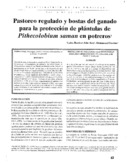| dc.description.abstract | Durante la estación húmeda se estudió en Rivas, Nicaragua la sobrevivencia y el crecimiento de plántulas del árbol maderable Pithecolobium saman (Jacq.) Benth, sembrados en las "bostas" o directamente en el "suelo" en un potrero de Hyparrhenia rufa (Nees) Stapf, bajo tres cargas animales (normal, alta, muy alta; 1.3, 2.6 y 3.9 unidades animales ha-1). Después de cuatro ciclos de pastoreo, el efecto repelente de las bostas vs suelo redujo el ramoneo (<1 vs 6.5 por ciento, respectivamente) y el pisoteo (17 vs 56 por ciento, respectivamente) de P. saman. Además, los arbolitos en bostas crecieron el doble (6 vs 3.4 cm, respectivamente) durante este período de 33 días. Con bostas fue necesario utilizar una carga animal alta para evitar un excesivo crecimiento de H. rufa adyacente a las bostas, lo cual puede reducir la sobrevivencia y el crecimiento de los arbolitos de P. saman.
A study of the survival and growth of seedlings of the timber species Pithecollobium saman (Jacq) Benth, growing in cow pats pr directly in the soil in a pasture of Hyparrhenia rufa (Necs) Stapf, comparing three grazing intensities (normal, high and very high; 1.3, 2.6 and 3.9 animal units ha-1), was carried out in Rivas, Nicaragua. After four grazing cycles, the repellent effect of the cow pats vs soil reduced browsing (<1 vs 6.5%, respectively) and trampling (17 vs 56%, respectively) of P. saman. Furthermore, seedlings growth in cow pats was double that in soil (6 vs 3.4 cm, respectively) during this 33 day period. When cow pats were used as a growth medium, it was necessary to utilize a high grazing intensity to avoid excessive growth of adjacent H. rufa, which can reduce the survival and growth of P. saman seedlings. | es_ES |


